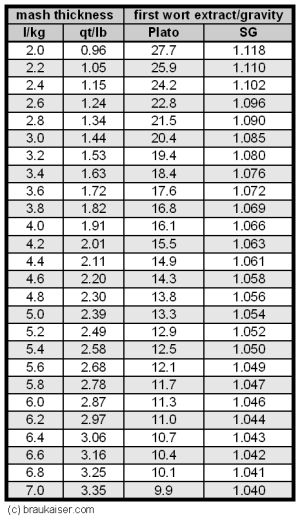Pol, you may want to check the first wort gravity. Should come close to what is listed in this table:
It if is there is not much more to get in terms of efficiency unless you start lautering more efficiently. But that can have quality impacts.
Kai
Hey Kai, I wanted to thank you for posting this chart, and later comments about the relationship of both conversion & lautering efficiency to total efficiency.
I'm very happy that I've kept detailed records of all my AG batches, including the first wort gravity. Using the chart I can see that:
Each time I've done a decoction (1.75 qt/#), I get within a point of the expected first wort SG.
The 3 times I did 8 hour mashes, I got 3-4 points more than expected. (I attempted this to allow brewing on week days, and I've stopped due to the resulting beers being overly attenuated).
All the rest of my barley batches have been 5-10 points lower than expected. I'd been mashing around 1.25 to allow a larger mashout volume to hit 168F, and I clearly need to try mashing at 2 qt/#.
A question that I have concerned doing hefeweizens, which I've done twice with 50/50 barley/wheat. Those two are about 15 points lower than expected. Any suggestions on what I should do differently with wheats?
For my next hefeweizen, I plan on doing an acid rest at 111F to help produce more clove flavor, so I'll use 1 qt/# to 111, and then another 1 qt/# to hit 152.





















![Craft A Brew - Safale S-04 Dry Yeast - Fermentis - English Ale Dry Yeast - For English and American Ales and Hard Apple Ciders - Ingredients for Home Brewing - Beer Making Supplies - [1 Pack]](https://m.media-amazon.com/images/I/41fVGNh6JfL._SL500_.jpg)




































